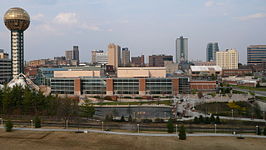|
Knoxville metropolitan area
The Knoxville metropolitan area, commonly known as Greater Knoxville,[3] is a metropolitan statistical area (MSA) centered on Knoxville, Tennessee, the third largest city in Tennessee and the largest city in East Tennessee. It is the third largest metropolitan area in Tennessee. In 2020, the Knoxville metro area (the MSA as defined by the United States Census Bureau) had a population of 879,773, and a population of 903,300 including Grainger County.[1] The Knoxville–Morristown–Sevierville Combined Statistical Area (CSA) had a population of 1,156,861 according to the census bureau in 2020. DefinitionsAs defined at the time of the 2010 United States Census, the Knoxville area was the third largest Metropolitan Statistical Area (MSA) in Tennessee. It retained that ranking in the 2020 United States census. For Census purposes, the Knoxville MSA was defined in 2013 to consist of the following nine Tennessee counties:[4]  Though sometimes considered to be part of the Knoxville metro area, the Census Bureau officially classifies Sevier County separately as the Sevierville micropolitan area, while Jefferson County is included in the Morristown metropolitan area.[4] Grainger County was a part of both the Knoxville metropolitan and the Morristown metropolitan[6] until 2023 when it was removed from the Morristown MSA.[7] The Knoxville MSA is the chief component of the larger Knoxville–Morristown-Sevierville, TN Combined Statistical Area (CSA), which also includes the Morristown metropolitan area (Hamblen, Jefferson, and Grainger counties) and the Sevierville (Sevier County), LaFollette (Campbell County), Harriman (Roane County), and Newport (Cocke County) Micropolitan statistical areas.
HistoryU.S. federal government definitions of the Knoxville metropolitan area have varied over time. The metropolitan area was first defined in 1947 and consisted of Anderson, Blount and Knox counties. Union was added in 1970, and the area was renamed the Knoxville Standard Metropolitan Area. Grainger, Jefferson and Sevier counties were added in 1980, and it became the Knoxville Metropolitan Statistical Area. Grainger and Jefferson counties lost metropolitan status in 1990. Loudon County was added in 2000. Grainger County was re-added in 2013. In new federal definitions of metropolitan areas announced in February 2013, the Knoxville Metropolitan Statistical Area was redefined.[4] Campbell, Grainger, Morgan and Roane Counties were added to the MSA, making it a nine-county metropolitan region.[5] Three of the four added counties were previously classified as components of the CSA, when Campbell and Roane counties were treated as the LaFollette and Harriman micropolitan areas, respectively, while Grainger County was part of the Morristown Metropolitan Statistical Area. Morgan County was not previously included in any metropolitan or micropolitan area, nor was it previously considered part of the CSA. The 2010 population of the redefined MSA was 837,571,[8] making it 64th largest of MSAs in the United States. The February 2013 announcement also included a new definition of the CSA associated with the Knoxville metropolitan area, renaming it the Knoxville–Morristown–Sevierville, TN Combined Statistical Area. In addition to the Knoxville MSA, the CSA includes the Morristown MSA and the Newport, Tennessee, and Sevierville Micropolitan Statistical Areas.[4] The newly defined CSA consists of the same twelve counties as the previous CSA, plus Morgan County. As of 2010, the Knoxville CSA ranked as 51st largest in the United States with a 2010 census population of 1,077,073. It has an estimated 1,096,961 residents as of 2014, making it the 50th largest CSA.[9] Knoxville economic areaAs of 2004, the federal government's Bureau of Economic Analysis (BEA) identified the Knoxville Economic Area as consisting of the Knoxville–Sevierville–LaFollette CSA (as it was then defined) plus Bell County, Kentucky, and Claiborne, Hancock, Monroe, Morgan and Scott counties in Tennessee.[10][11] BEA defines economic areas as metropolitan or micropolitan statistical areas that form regional centers of economic activity, plus the surrounding counties that are determined to be economically related to these centers of activity, based on a combination of census commuting data and newspaper circulation data supplied by the Audit Bureau of Circulations.[11] The Knoxville Economic Area was one of 179 economic areas that the BEA identified in the United States as of 2004.[12] Combined statistical areaThe Knoxville–Morristown–Sevierville Combined Statistical Area consists of the following: CountiesCommunitiesPlaces with more than 100,000 inhabitants
Places with 10,000 to 33,000 inhabitants
Places with 1,000 to 10,000 inhabitants
Places with less than 1,000 inhabitants
See alsoReferences
External links |
||||||||||||||||||||||||||||||||||||||||||||||||||||||||||||||||||||||||



